
Heart Rate Monitor with Speed and
Distance
MODEL: SE302
USER MANUAL
INTRODUCTION
Thank you for selecting the Heart Rate Monitor as your
sports fitness product of choice.
IMPORTANT This product is for sport purposes only and
it is not meant to replace any medical advice. This manual
contains important safety and care information, and provides
step-by-step instructions for using this product. Read the
manual thoroughly, and keep it in a safe place in case you
need to refer to it later.
TRAINING INFORMATION
HOW THE HEART RATE MONITOR HELPS YOU
A heart rate monitor is the most important tool in
cardiovascular health and an ideal training partner. It enables
you to see and monitor results. This helps you assess your
past performance, maximize your workout and adapt your
future exercise program to achieve your desired goals in a
safer and more effective way.
When you exercise, the chest belt picks up your heartbeat
and sends it to the watch. Now you can view your heart rate
and start monitoring your performance based on your heart
rate readings. As you get fitter, your heart will need to do
less work and the speed of your heartbeat will decrease. The
reason for this is as follows:
• Your heart pumps blood to your lungs to obtain oxygen.
Then, the oxygen rich blood will travel to your muscles.
The oxygen is used as fuel and the blood leaves the
muscles and returns to the lungs to begin the process
again. As you get fit, your heart is able to pump more
blood with every beat. As a result, your heart doesn’t
have to beat as often to get the necessary oxygen to
your muscles.
TRAINING TIPS
To gain maximum benefit from your training program and to
ensure that you exercise safely, please observe the following
guidelines:
• Start with a well-defined training goal, such as to lose
weight, keep fit, improve health or compete in a sporting
event.
• Select a training activity you enjoy and vary your training
activities to exercise different muscle groups.
• Start slowly, and then gradually step up your workout
as you become fitter. Exercise regularly. To maintain a
healthy cardio-vascular system, 20-30 minutes three
times a week is recommended.
• Always allow at least five minutes before and after
exercising for warm-up and cool-down.
• Measure your pulse after training. Then repeat the
procedure again after three minutes. If it does not return
to its normal resting rate, you may have trained too
hard.
• Always check with your doctor before starting a vigorous
training program.
PRODUCT OVERVIEW
WATCH
1. LCD screen
2. MEM / - : Display training records; decrease setting
value
3. MODE: Switch to another display Mode; press and hold
to search signal
4. ST / SP / + : Start / stop timer; increase setting value
5. / : Turn on backlight for 3 seconds; lock /
unlock the keypad
6. SET: Enter setting mode; confirm setting; display
different information during training or memory mode;
reset timer / stopwatch
LCD
1. Area 1
2. Area 2
3. Area 3
4. Area 4
Area 1
1. WARM: Warm-up timer is shown or running
2. REST: Recovery timer is shown or running
3. TIMER: SMART TRAINING PROGRAM is shown or
running
4. TTL: Total exercise time is displayed
5. : Stopwatch is shown or running
6. Key tone is enabled
7. Backlight is enabled
Area 2
1. / : Hour / minute / second separators
2. Stopwatch or exercise time
3. KCAL: Number of calories
4. : Alarm is enabled
5. Unit of speed / distance
Area 3
1. % fat : Percentage of fat burned
2. : Icon animated when a speed reading
is being taken
3. / : Flashes when heart rate is out of zone
4. Displays information
5. cm : Height shown in centimeters
6. Kg / lb: Unit of weight
7.
/ : Height shown in feet / inches
8. : Repeat function is activated
9. Number of times repeated
10. AM / PM icon
Area 4
1. / : pace display
2. : Flash when speed is out of zone
3. Avg : Average heart rate / average speed / average
pace is displayed
4. Max : Maximum value of speed and distance is
displayed
5. Unit of speed
6. : Heart rate is above or below limit; audio heart rate
alert is activated
7. : Flashes when a signal has been found
8. : Flashes when auto-searching heart rate signal
9. : Battery status
10. : Keypad lock is enabled
GETTING STARTED
UNPACKING THE WATCH
In this box, you will find:
• Watch
• Heart rate chest belt
• Adjustable elastic belt
• Bike mount
• 2 x CR2032 lithium batteries (already installed)
To turn on the watch (first time use only):
Press any key for 2 seconds to activate the LCD.
NOTE To ensure accuracy, calibrate the watch before first
use (see Calibration section for more information).
WEARING THE CHEST BELT AND WATCH
CHEST BELT
The heart rate chest belt is used to count your heartbeat and
transmit the data to the watch.
To wear the chest belt:
• Wet the conductive
pads on the underside
of the chest belt with a
few drops of water or a
conductive gel to ensure
solid contact.
• Strap the heart rate chest
belt across your chest.
To ensure an accurate
heart rate signal, adjust
the strap until the belt
sits snugly below your
pectoral muscles.
TIPS
• The position of the chest belt affects its performance.
Move the chest belt along the strap so that it falls above
your heart.
• Avoid areas with dense chest hair.
• In dry, cold climates, it may take several minutes for the
chest belt to function steadily. This is normal and should
improve with several minutes of exercise.
• To maintain the best performance of your chest belt,
please handle it with care according to the following:
- Do not wrap the chest belt in a wet towel nor with
other wet materials.
- Do not store the chest belt in a hot (about 50°C) and
humid (about 90%) environment.
- Do not place or wash the chest belt under running
water, instead clean it with a wet cloth.
- Do not place the conductive rubber face down on a
metal table or surface.
- Properly dry the chest belt immediately after use.
WATCH
You can wear the receiver on your wrist or strap it to a bike
or exercise machine as shown below.
TRANSMISSION SIGNAL
The chest belt and watch have a maximum transmission
range of about 62.5 centimeters (25 inches). They are
equipped with the latest digital coding system to reduce
signal interference from the environment and for more
accurate readings.
NOTE Whenever the watch is searching for the chest
belt signal (manual or automatic search), make sure that
the chest belt is no further than 10 cm (4 inches) from the
watch.
ICON DESCRIPTION
The outer heart flashes
Searching for a
signal
The inner heart flashes
A signal has been
found
No signal has
been found
NOTE
If the watch is kept idle without receiving a signal
from the chest belt for 5 minutes, the heart rate and speed
functions will be turned off.
IMPORTANT If the heart rate icon does not appear on the
display or is not flashing because no signal has been found,
force a signal search. See “Signal Search” section for how
to do this.
In the event that you experience a weak signal or your signal
is disrupted by interference in the environment, follow the
instructions below to identify and resolve the situation.
1. The signal is weak – the watch will only show “0”:
• Shorten the distance between the heart rate chest
belt and watch.
• Re-adjust the position of the heart rate chest belt.
• Check the batteries. If they are low or exhausted,
the range may be less.
• Force a signal search (see “Signal Search”
section).
2. Interference from another person’s heart rate monitor
– their heart rate readings appear on your watch, or the
watch shows “0”:
• Take the chest belt off for 12 seconds to
automatically change your User ID. (The watch has
4 User ID’s. When the watch receives the chest belt
signal, it will tell you which User ID it has selected.
Only products with a digital coding system have
User ID capability.)
NOTE The heart rate readings may interfere with other
users if the distance is less than 84 cm (33 inches).
3. The signal is jammed – the heart rate reading on your
watch is flashing:
• There is too much interference in the environment
for your heart rate monitor to function. Move to an
area where the heart rate reading stops flashing.
WARNING Signal interference in the environment can
be due to electromagnetic disturbances. These may occur
near high voltage power lines, traffic lights, overhead lines
of electric railways, electric bus lines or trams, televisions,
car motors, bike computers, some motor driven exercise
equipment, cellular phones or when you walk through electric
security gates. Under interference, the heart rate and speed
readings may become unstable and inaccurate.
SIGNAL SEARCH
To force a signal search:
1. Press
MODE to enter TRAIN or CHRONO Mode.
2. Press and hold
MODE for 2 seconds. The signal-
searching icon with the outside flashing will appear to
confirm a signal search is taking place. Whenever the
watch is searching for the chest belt signal, make sure
that the chest belt is no further than 10 cm (4 inches)
from the watch.
The signal search will take approximately 10 seconds. If
after 10 seconds the heart icon is not flashing, then your
signal search has been unsuccessful and you need to force
another signal search. See the table in the “Transmission
Signal” section for more signal status information.
SETTING THE KEYPAD TONE / LIGHT MODE
You can set the watch to have the:
• Keypad “Beep” tone ON or OFF.
• Light Mode ON or OFF (see “Activating the Backlight”
section).
To set these features:
1. Press
MODE to enter TIME Mode.
2. Press
SET until you reach the feature you wish to
change.
3. Press ST / SP / +
or MEM / - to change the setting.
4. Press
SET to confirm the setting and move on to the
next one.
ACTIVATING THE BACKLIGHT
To activate when the Light Mode is set to OFF:
Press to turn on the backlight for 3 seconds. Press any
other key whilst the light is on and it will extend the light time
by another 3 seconds.
To activate when the Light Mode is set to ON:
Press any key to turn ON or extend the backlight for 3
seconds.
To help conserve power the Light Mode ON setting will
automatically switch to OFF after 2 hours.
NOTE The backlight does not work when the low battery
icon is shown and will return to normal once the battery is
replaced.
ACTIVATING THE KEYPAD LOCK
To turn the keypad lock ON or OFF:
• Press and hold
. appears on the display
when the keypad lock is on.
SWITCHING BETWEEN OPERATION MODES
Press MODE to switch between the 4 operation modes:
• TIME: Real-time clock and Alarm
• TRAIN: Warm-up timer / Exercise timer / Rest (recovery)
timer
• CHRONO: Stopwatch
• USER: Exercise and User profile.
The modes are described in the sections that follow.
NOTE You can run the SMART TRAINING PROGRAM or
stopwatch in the background as you access other modes.
The icon for the mode that is running will flash until you
switch back to that mode.
CLOCK
To set real-time clock:
1. Press
MODE to switch to TIME mode.
2. Press and hold SET until the first setting flashes.
3. Press ST / SP / + or MEM / - to change the 12 or 24 hour
clock format setting. Hold down for fast advancement.
Press SET to confirm the setting and move on to the
next one.
4. Repeat step 3 to change other settings: Hour / Minute /
Year / DD:MM or MM:DD date format / Month / Day.
NOTE The clock is programmed with a 50-year auto-
calendar, which means you do not need to reset the days of
the week and dates each month.
ALARM
The alarm can be set to activate daily (Mon-Sun), on
weekdays (Mon-Fri) or on the weekend (Sat-Sun).
To set alarm:
1. Press MODE to enter TIME mode.
2. Press SET to select alarm.
3. Press and hold SET until the first setting is flashing to
enter the setting mode for the alarm.
4. Press ST / SP / + or MEM / - to change the Daily,
Weekday or Weekend setting. Hold down for fast
advancement. Press SET to confirm the setting and
move on to the next one.
5. Repeat step 4 to change other settings: Hour / Minute.
6. The alarm will automatically be activated once you have
finished setting the alarm time.
To activate / deactivate the alarm:
1. Press
MODE to enter TIME Mode.
2. Press
SET to select alarm.
3. Press ST / SP / + or MEM / - to activate or deactivate
the alarm. The alarm icon
displays when the alarm is
activated.
To turn the alarm sound off:
Press any key to turn the alarm sound off. The alarm will
automatically reset itself unless you deactivate it.
USER PROFILE
To access the full benefits of the heart rate monitor set up
your user profile before you exercise. This will automatically
generate a fitness index and body mass index. These
calculations along with the calorie and % fat burned will help
you track your progress over time.
To set user profile:
1. Press MODE to enter User Profile.
2. If this screen appears, press SET to enter the User
Profile.
3. Press and hold SET until the first setting flashes.
4. Press ST / SP / + or MEM / - to change the Male or
Female setting. Hold to speed through the options.
Press SET to confirm the setting and move on to the
next one.
5. Repeat step 4 to change other settings: Year of Birth /
Month of Birth / Day of Birth / Weight - lbs or Kg option /
Weight / Height - feet / inch or centimeter option / Height
/ Activity Level - Little, Hobby or Athlete.
Once you complete your user profile, a fitness index and
body mass index is automatically calculated and displayed
for you. Refer to the “About the Fitness / Body Mass Index”
section for further information.
NOTE You can display and adjust your user profile at any
time.
NOTE You must set up your user profile to use the calorie
count and % fat burned features.
ACTIVITY LEVEL
The activity level is based on your own self-assessment of
the amount of exercise you regularly perform.
ACTIVITY LEVEL DESCRIPTION
LITTLE
Low – You do not usually
participate in programmed
recreation sports or exercise
HOBBY
Medium – You are engaged in
modest physical activity (such as
golfing, horseback riding, table
tennis calisthenics, bowling, weight
lifting or gymnastics) 2-3 times a
week, totaling 1 hour per week.
ATHLETE
High – You actively and regularly
participate in heavy physical
exercise (such as running, jogging,
swimming, cycling, or skipping
rope) or engage in vigorous aerobic
exercise (such as tennis basketball
or handball).
EXERCISE PROFILE
To use the SMART TRAINING PROGRAM you need to set
the exercise profile.
Different activities exercise the body in different ways
and help you to achieve a variety of fitness goals. To
accommodate this, the exercise profile can be set to suit
different exercise activities. For example, if you are running,
your exercise profile settings are likely to differ from those
you would use when undertaking a weight training activity.
Also, the time you require to warm-up and complete an
exercise will vary. That is why you can change the warm-up
and exercise countdown time to suit you.
To set exercise profile:
1. Press
MODE to enter USER Mode
2. Press SET to enter Exercise Profile.
3. Press and hold SET until the first setting flashes. The
display will change to “WALK”, “JOG” or “RUN” after a
while.
4. Press ST / SP / + or MEM / - to change the walk / jog
/ run setting. Hold to speed through the options. Press
SET to confirm the setting and move on to the next
one.
5. Repeat step 4 to change other settings:
• Lower Limit Heart Rate
• Upper Limit Heart Rate
• Heart Rate Alert ON or OFF
• Repeat Exercise Timer ON or OFF
• Exercise Timer or Distance / Distance (if Distance is
chosen)
• Exercise Timer Hour (if Timer is chosen)
• Exercise Timer Minute (if Timer is chosen)
• Warm-Up Timer (set to 5, 10, 15 mins to activate or
0 to deactivate timer)
• Rest (Recovery) Timer ON or OFF
NOTE
Once you have set your user profile and target activity
your lower and upper heart rate limit will be set automatically.
However, If the automatic settings don’t suit you, you can
manually change them. If you change the target activity, they
will automatically be updated.
TARGET ACTIVITY
There are 3 target activity levels:
TARGET ACTIVITY MHR% DESCRIPTION
WALK
Health
Maintenance
65-78%
This is the lowest
training intensity
level. It is good
for beginners and
those who want to
strengthen their
cardiovascular
systems.
JOG
Aerobic
Exercise
65-85%
Increases strength
and endurance. It
works within the
body’s oxygen intake
capability, burns more
calories, and can be
maintained for a long
period of time.
RUN
Anaerobic
Exercise
78-90%
Generates speed
and power. It works
at or above the
body’s oxygen intake
capability, builds
muscle and cannot
be maintained for a
long period of time.
MAXIMUM / LOWER / UPPER HEART RATE LIMIT
Before you begin any exercise program and to achieve
maximum health benefits from your workout, it is important
to know your:
• Maximum heart rate (MHR)
• Lower heart rate limit
• Upper heart rate limit
To manually calculate your own heart rate limits, follow the
instructions below:
MHR LOWER LIMIT UPPER LIMIT
MHR = 220
– age
MHR x lower
target activity %.
E.g. Target
activity is WALK
Lower Limit =
MHR x 65%
MHR x upper target
activity %.
E.g. Target activity is
WALK Upper Limit =
MHR x 78%
HEART RATE ALERT
You can set the heart rate alert in the exercise profile to the
following settings:
ICON DESCRIPTION
Heart rate sound is OFF
Heart rate sound alert is ON
• 1 beep means you have gone
below your lower zone limit
• 2 beeps means you have gone
above your upper zone limit
When the heart rate alert is activated, a flashing down or up
arrow will appear on the display to show which heart rate
limit you have surpassed.
CALIBRATION AND SPEED
CALIBRATION
Before using the speed and distance function, you need to
calibrate for both running and walking. You do this by entering
a pre-set distance and using the watch to determine a rough
estimate of your speed (for both running and walking). This
is called the real calibration.
To set real calibration:
1. Make sure the transmission between the watch and
chest belt is well connected.
2. Press
MODE to enter TRAIN mode.
3. Press and hold
SET to enter setting mode.
4. Press ST / SP / + or MEM / - to select calibration (CALI)
and press SET to confirm.
5. Press ST / SP / + or MEM / - to select walking or running.
You must do both walking and running separately. The
watch can automatically distinguish if you are walking or
running.
6. Press ST / SP / + or MEM / - to select the distance you
will walk / run and (400 meters is suggested) and press
SET to confirm.
7. Press ST / SP / + to start calibration and then
immediately
start walking or running.
8. Once you have completed the distance set, press ST /
SP / + to end calibration. It is very important to end the
calibration by pressing ST / SP / + to ensure accurate
operation of the heart rate monitor.
9. The watch can detect whether the calibration has been
accurate or not. If calibration has failed you can redo it
by pressing
SET and repeating steps 8 and 9, or cancel
by pressing ST / SP / +.
10. Repeat again so that both walk and run are calibrated.
IMPORTANT If an in-progress calibration is interrupted,
you must restart and complete calibration before using the
unit again.
TIPS
• The speed and distance function is only for running or
walking, not for cycling or driving.
• When calibrating running, for a more accurate calibration
please run below 15km/h (or 3 steps per second).
• The watch will show the estimated distance completed
during calibration. If the final estimate is 20% over or
under the set distance, we suggest recalibration.
• The calibration depends on the body’s walking or
EN

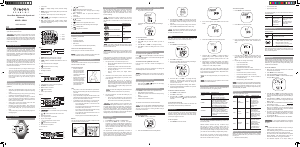


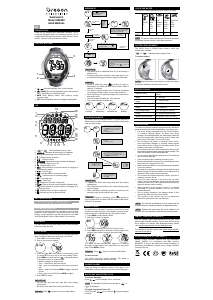

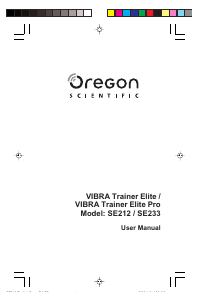
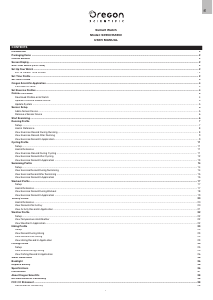
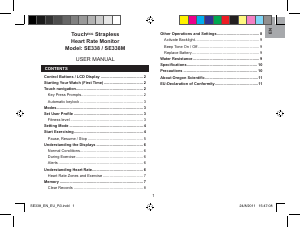
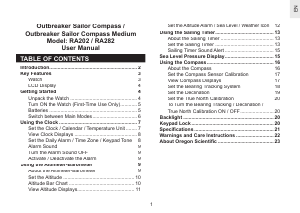
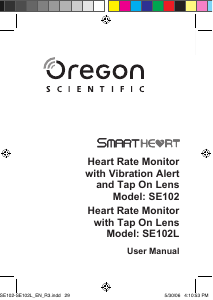

Praat mee over dit product
Laat hier weten wat jij vindt van de Oregon SE302 Sporthorloge. Als je een vraag hebt, lees dan eerst zorgvuldig de handleiding door. Een handleiding aanvragen kan via ons contactformulier.